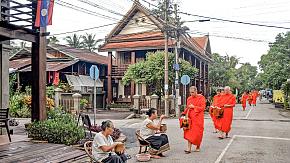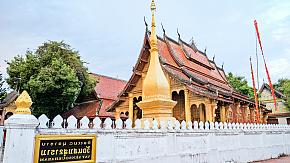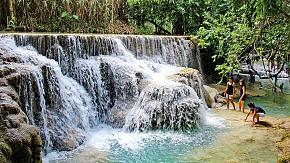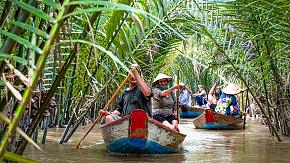5 Best Places to Visit in Laos
One of South-East Asia's least known countries is also one of its loveliest, despite centuries of damage from wars, occupations and monsoons. Sandwiched between Vietnam and Thailand, with China and Myanmar to the north and Cambodia to the south, lovely Laos is South-East Asia's only landlocked country. But hey! Who needs the sea or shores when your country sits on one of the world's greatest rivers and you are noted for your spectacular waterfalls? Among so much more!
The mighty Mekong River rises in Tibet, and then flows through China's Yunnan province into Myanmar/Burma before leaving for Laos where it spends a lot of time forming the border with Thailand, but occasionally meandering deeper into Laos, before heading into Cambodia then finally emptying into the sea in the Mekong Delta area of Vietnam.
The river is a huge reservoir of biodiversity, second only to the Amazon, and its basin is reported to have over 20,000 plant species, 430 mammals, 1,200 birds, and 800 reptiles and amphibians. New species to science are still being found every year. It also has more large fish than any other river, with some specimens reaching up to five meters in length. Unfortunately, many of these larger fish are under threat due to dams and overfishing. The Mekong's once common Irrawaddy dolphin population is believed to have fallen as low as 92 according to the World Wildlife Fund (WWF).
But, important as the river is environmentally, economically, and even culinarily, it is not the only reason to visit Laos. Here, I hope to tempt you, with some of the country's best must-see sights and experiences, both on and off the river.
LUANG PRABANG
Luang Prabang, the former capital of Laos, lies at the confluence of the Mekong and Nam Khan Rivers, in the centre of the northern part of the country. Most of the city has been declared a UNESCO World Heritage Site for its well-preserved architecture, a unique mix of local and French colonial styles, as well as for its religious and cultural heritage.
 Wat Xieng Thong
Wat Xieng Thong
Luang Prabang is known for its many wats or Buddhist temples and still active functioning monasteries. The 16th century Wat Xieng Thong is one of the most important temples in Laos with its royal connections which only ended in 1975. This is where Lao kings were crowned. The wat consists of several buildings and is set in beautiful gardens. Look out for the carved gilded doors to the buildings, depicting scenes from the Buddha's life. There are many other smaller wats throughout the city. One popular event not to miss takes place at dawn, when the temple monks come out and walk the streets of the city receiving alms from the local citizens. The monks get food; the citizens get good karma.
 The alms-giving ceremony
The alms-giving ceremony
Also very much worth visiting is the former Royal Palace, home to the Lao kings until 1975 when the monarchy was deposed. Today, the palace is a fascinating museum, officially known as Haw Kham Royal Palace Museum. The main building is an interesting blend of Lao and French architecture, and is full of Lao art as well as paintings and other gifts presented by diplomats and visiting heads of state from around the world. Don't forget to visit the throne room which now displays the rich Lao royal jewels, now state property. Also, the royal apartments have been preserved as they were in 1975 and are open to the public. Outlying buildings include the royal kitchens and the royal barge shelter.
 The formal Royal Palace
The formal Royal Palace
Apart from its royal legacy, Luang Prabang also offers plenty in the way of natural sights. Kuang Si Falls are about 29 kilometers /18 miles south of the city and consist of a three stage drop from pool to pool starting at the top of a hillside. The main drop is one of 60 meters / 200 feet. It is possible to swim in some of the pools, but others are considered sacred and are off-limits to swimmers. Less busy are the Tat Sai Falls, a similar distance from the city, but these are only worth visiting in the rainy season (June to August) as they tend to dry up for most of the year.
 Kuang Si Falls
Kuang Si Falls
Many visitors like to visit the Pak Ou caves, 25 kilometers / 15.5 miles north of the city. Here are two caves, the upper and lower. Here you will see hundreds of tiny Buddha statues, most carved from wood, laid out on shelves around the cave walls. There is a tradition among the local people to deposit any old or broken Buddha statues here. It is possible to arrange to combine a visit to the caves with a kayak trip on the Mekong.
Back in the city, the more agile visitor may like to climb the steps of the 100 meter / 328 feet high Mount Pho Si, passing numerous Buddhist shrines, to the top where they will find Wat Chom Si with its gilded stupa. The hill offers a spectacular view over the whole city and the Mekong.
 A beautiful view of Luang Prabang from Mount Pho Si
A beautiful view of Luang Prabang from Mount Pho Si
While in the area you may like to sample Luang Prabang's favorite dish – Or Lam. This is a stew of beef, game meat or chicken, lemongrass, chilies, mashed eggplants, wood ear mushrooms, and yard long beans. It also usually contains a mixture of herbs, some only found in Laos. Other favourite dishes include fish with fried river moss, both from the Mekong or the city's other river, the Nam Khan. All of these and more are available at the city's night market.
XIANG KHOUANG PROVINCE
South-east of Luang Prabang, is the province of Xiang Khouang. This province contains one of the most mysterious pre-historic sites in the world – the Plain of Jars. Across the plain are over 90 sites containing thousands of stone jars scattered in groups varying from just a few to hundreds. Scientists and archaeologists believe these jars formed part of some kind of funerary rites and the place is a huge burial site, but many questions remain unanswered.
 The Plain of Jars
The Plain of Jars
IMPORTANT WARNING: Do not attempt to explore this area on your own. During the Vietnam War, the American Air Force dropped millions of cluster bombs in the area. Many of these failed to explode and are still scattered around the plateau posing a great danger to the unwary. Twelve numbered sites have been cleared and are safe to visit. Sites 1 to 3 are the largest and most popular. Work continues to clear more.
Site 1, with over 300 hundred jars, also contains a cave with two holes leading up to the sky like chimneys. This is thought to have been a crematorium, adding credence to the funerary theory. This site also has a visitors' center where you can learn about the history of the site and the various theories. Information is available in English.
Also in Xiang Khouang, it is rewarding to take a trip into some of the hill tribe people's villages for a look at life in the Laotian countryside. Many of these villages, inhabited by the Hmong and Tai Dam ethnic minorities can be found near the old capital city, Muang Khoun, itself an interesting place.
The former royal city has been destroyed over and over again by war and weather. It was heavily bombed during the first Indochina War and again in the Vietnam War, leaving almost everything in ruins. Miraculously one Buddha statue remains undamaged at Wat Phia Wat and stands proud and serene among the ruins.
VIENTIANE
Also on the banks of the Mekong, bordering Thailand is Vientiane, the capital of Laos. This is the country's largest city and by Lao standards, it's most cosmopolitan. That is not to say that it isn't home to Lao tradition. In fact, one of the most iconic sites in Laos is right here. The large, gold covered stupa sits in the city center and its architecture reflects Laotian culture and identity.
The former temple, Wat Prakeo, once home to the Emerald Buddha, now in Bangkok, Thailand, is now a museum full of prime examples of Laotian religious art: hundreds of Buddha statues, steles, wood carvings and much more. The museum is set in attractive landscape gardens.
 Wat Prakeo
Wat Prakeo
Also popular in Vientiane is Talat Sao Morning Market. Despite the name, the market is open from 7 am until around 4 pm, selling everything from fruit and vegetables to silk and jewelry, arts and crafts, musical instruments, electrical goods etc; a good place to seek out souvenirs. It also contains a number of restaurants.
SAVANNAKHET
Savannakhet, often unofficially abbreviated to Savan, in the west of Laos, facing Thailand across the Mekong, is the second largest city in Laos, after Vientiane. The pleasant city and the surrounding province are noted for two things.
First is dinosaurs! Budding or experienced paleontologists will delight in the surrounding area, which contains five important fossil sites. The best known is the 110 million-year-old, Tang Vay. Among many other fossils found here have been a sauropod, a psittacosaurus and a theropod. If you know what these are, and I don't, you will surely be fascinated by the place. There is a small dinosaur museum in Savan city where the exhibits are labeled in Lao and French only.
Secondly, the city is noted for its multicultural nature with influences from Thailand, Vietnam, China and France. Here you can find Lao, Chinese, Thai and Vietnamese temples as well as a Catholic cathedral and a mosque.
In 2007, a Thai–Lao Friendship Bridge opened across the river, connecting the city to Thailand. The 1,600 meter- / 5,250 feet-long bridge is an important transport link as well as being an important symbolic link.
PAKSE
Pakse is the capital city of Champasak province in the far south-east of Laos, bordering Cambodia to the south and Thailand to the east. Near to the city and bordering Cambodia is Si Phan Don, which means "4000 Islands". This archipelago sits in the Mekong and consists of several islands, some of which disappear underwater when the river is in full flow. Off the island of Don Khon (not to be confused with Don Khong) is one of the very few places you may be lucky enough to catch a glimpse of highly endangered Irrawaddy dolphins.
The largest island in the group is Don Khong or Khong Island. This island is 18 kilometers / 11 miles long (north-south), and 8 kilometers / 5.0 miles at its widest point. It is a great place to relax or explore. The island has very good infrastructure compared to many rural parts of Laos, something many people attribute to a former president of Laos deciding to retire there!
Also, near Pakse are the ruins of Wat Phu or Phou. This Khmer temple dates from the 11th to 13th centuries and like so many across south-east Asia was originally a Hindu temple, dedicated to Shiva, before becoming a Buddhist shrine. The un-restored, but conserved ruins are a fascinating glimpse into a lost culture.
Whenever I visit Laos, one of my favourite countries, I am struck not only by its rich culture, magnificent scenery and wonderful food but, most of all, by the friendliness and positivity of the people, who despite their often troubled history retain that serenity you find in so many places in this part of the world.
 Laotian kids
Laotian kids
Whatever you do, don't forget your camera and plenty of memory cards. You are guaranteed to take more photographs than you planned on!
Remember that Odynovo can create a custom private tour for your family or group of friends to Laos or any of over 70 destinations around the world – all with private guides and drivers. Just let one of our travel experts know your preferences, desires, and budget and they will design you a free itinerary to consider with no obligation. You are free to adjust or tweak this at any time before confirming any booking.
Quick Question
What Our Clients Say
Explore the latest verified reviews of Odynovo's travel services on Tripadvisor, Google, Trustpilot, Product Review and more trusted platforms.





